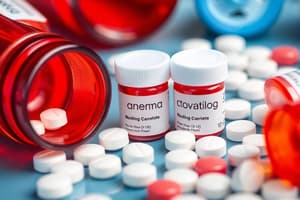Podcast
Questions and Answers
What are the three important dysfunctions of blood commonly treated with various agents?
What are the three important dysfunctions of blood commonly treated with various agents?
- Thrombosis, bleeding, anemia (correct)
- Thrombosis, hypertension, diabetes
- Bleeding, diabetes, anemia
- Hypertension, thrombosis, anemia
What is the normal platelet count per microliter of blood?
What is the normal platelet count per microliter of blood?
150,000-450,000
What is the process by which blood forms clots?
What is the process by which blood forms clots?
Coagulation or clotting
Platelets are also known as thrombocytes.
Platelets are also known as thrombocytes.
Prothrombin is present in blood plasma that is converted into active thrombin by a clotting factor known as factor _.
Prothrombin is present in blood plasma that is converted into active thrombin by a clotting factor known as factor _.
What is the role of Adenosine diphosphate (ADP) in platelet activation?
What is the role of Adenosine diphosphate (ADP) in platelet activation?
What is the function of Thromboxane A2 in the context of platelets?
What is the function of Thromboxane A2 in the context of platelets?
How do Clopidogrel and Aspirin act as antiplatelets?
How do Clopidogrel and Aspirin act as antiplatelets?
What is the mechanism of action of Tranexamic acid?
What is the mechanism of action of Tranexamic acid?
Name two Glycoprotein IIb/IIIa receptor antagonists and explain their mechanism of action.
Name two Glycoprotein IIb/IIIa receptor antagonists and explain their mechanism of action.
Flashcards are hidden until you start studying
Study Notes
Hematology System
- The hematology system includes three main components: erythrocytes (RBCs), leukocytes (WBCs), thrombocytes (platelets), and plasma.
Platelets
- Platelets are responsible for stopping bleeding by forming a clot.
- Normal platelet count is 1,50,000-4,50,000 per microliter of blood.
- Coagulation or clotting is the process by which blood forms clots.
- Clotting factors and anticoagulants are made in the liver.
Thrombosis
- Thrombosis is the formation or presence of a blood clot in a blood vessel.
- The vessel may be any vein or artery, such as in a deep vein thrombosis or a coronary artery thrombosis.
- The clot itself is termed a thrombus.
Prothrombin
- Prothrombin is a protein produced by the liver.
- Prothrombin is converted into active thrombin by a clotting factor known as factor X or prothrombinase during coagulation.
- Thrombin is an enzyme that causes the clotting of blood by converting fibrinogen to fibrin.
Stages of Blood Clotting
- Stage 1: Formation of prothrombin activator.
- Stage 2: Conversion of prothrombin into thrombin.
- Stage 3: Conversion of fibrinogen into fibrin.
Anticoagulants
- Anticoagulants are substances that prevent coagulation of blood.
- Types of anticoagulants:
- Anticoagulants used to prevent blood clotting inside the body (in vivo).
- Anticoagulants used to prevent clotting of blood that is collected from the body (in vitro).
- Anticoagulants used to prevent blood clotting both in vivo and in vitro.
- Examples of anticoagulants: Heparin, Warfarin, Rivaroxaban.
Heparin
- Heparin is a naturally produced anticoagulant in the body.
- Mechanism of action: prevents blood clotting by its antithrombin activity.
- Heparin is enhancing the activity of the endogenous inhibitor "antithrombin" by 1000 x.
Heparin Pharmacokinetics
- Absorption and Distribution: Heparin is unable to cross membranes, including those of the GI tract, and must be given by injection (IV or subQ).
- Metabolism and Excretion: Heparin undergoes hepatic metabolism and is excreted through the renal route.
- Half-life: short (about 1.5 hours), but increased in patients with hepatic or renal disease.
Antidote for Heparin
- Protamine sulfate is the antidote for heparin overdose.
- Dosage of protamine: 1 mg of protamine inactivates 100 units of heparin.
Rivaroxaban
- Rivaroxaban is an oral anticoagulant indicated for prophylaxis of deep vein thrombosis (DVT) and pulmonary embolism (PE) in patients undergoing knee or hip replacement surgery.
- Mechanism of action: Rivaroxaban inhibits both free Factor Xa and Factor Xa bound in the prothrombinase complex.
- Adverse effects: thrombocytopenia, retroperitoneal hemorrhage, hypersensitivity, cerebral hemorrhage.
Vitamin K
- Newborns are prone to vitamin K deficiency due to:
- Limited transport of vitamin K across the placental barrier.
- Immature prothrombin synthesis in the liver.
- Sterile gut, lacking bacteria necessary for vitamin K synthesis.
- Newborn infants receive a single dose of vitamin K at birth to prevent bleeding disorders.
Warfarin
- Warfarin is an anticoagulant used to prevent clots.
- Mechanism of action: Warfarin inhibits the vitamin K-dependent synthesis of clotting factors II, VII, IX, and X.
- Side effects: severe bleeding, including heavier than normal menstrual bleeding, hematuria, black or bloody stool, blood in vomiting, blood in sputum.
Fibrinolytics
- Fibrinolytics are substances that break down blood clots.
- Examples: Alteplase, Reteplase, Anistreplase, Streptokinase, Urokinase.
- Mechanism of action: Fibrinolytics activate plasminogen to produce plasmin, which breaks down fibrin.
Antiplatelets
- Antiplatelets are a group of medicines that stop blood cells (platelets) from sticking together and forming a blood clot.
- Examples: Aspirin, Clopidogrel, Prasugrel.
- Mechanism of action: Antiplatelets inhibit the activation of platelets by blocking the production of thromboxane A2 or by inhibiting the ADP receptor.
Tranexamic acid
- Tranexamic acid is an antifibrinolytic that competitively inhibits the activation of plasminogen to plasmin.
- Indications: used to treat or prevent excessive blood loss from major trauma, postpartum bleeding, surgery, tooth removal, and nose bleeds (epistaxis).
Studying That Suits You
Use AI to generate personalized quizzes and flashcards to suit your learning preferences.




